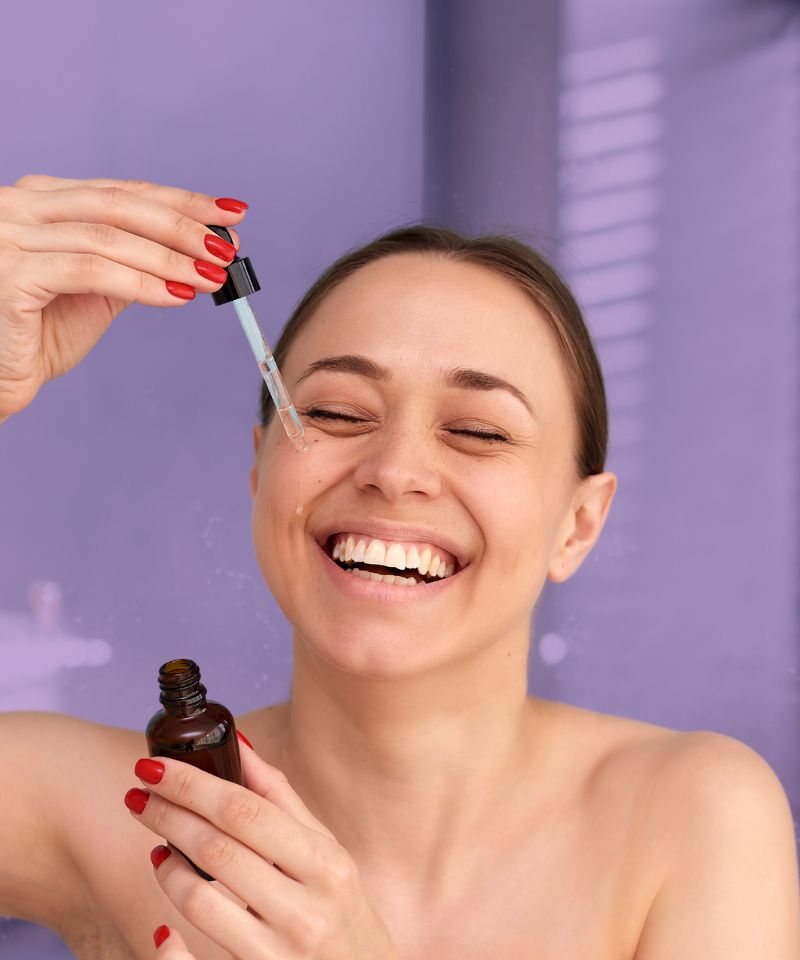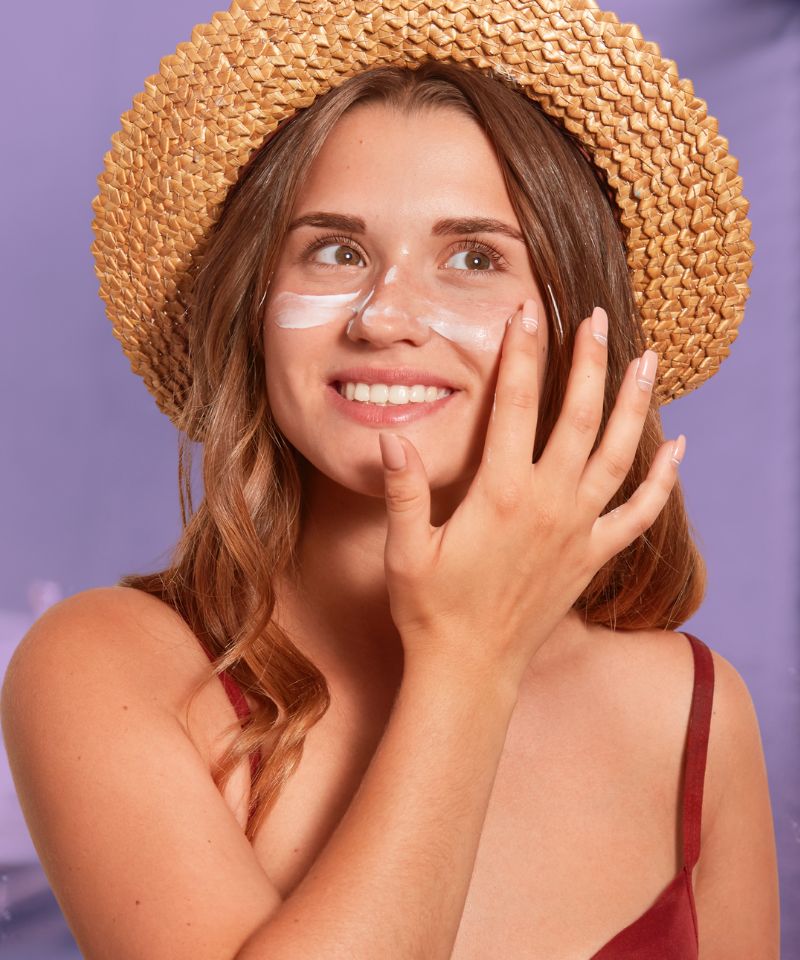Incorporating vitamin C and SPF into your skincare routine can significantly enhance your skin’s health and protect it from environmental damage.
However, the idea of mixing these products together may raise questions about efficacy and safety.
Therefore, in this guide, I will explain everything you need to know about mixing vitamin C serums and SPF creams and how to do it correctly for maximum benefits and no adverse effects.

Can You Mix Vitamin C Serum with SPF Creams?
Yes! You can mix a vitamin C serum with SPF creams.
According to recent studies, vitamin C can enhance the sunscreen’s effectiveness due to its antioxidant properties.
The antioxidant properties of vitamin C help neutralize free radicals and further protect the skin from photodamage caused by UV rays.
On the other hand, SPF creams protect against UV rays, which can degrade and destabilize vitamin C, allowing it to work more effectively and for a longer period.
Therefore, using both together can provide optimal protection for your skin.
However, it’s crucial to consider the pH levels and formulation of the vitamin C serum to avoid destabilizing the chemical composition of SPF creams, which can lead to reduced effectiveness or increased skin sensitivity.
How Do Vitamin C Serums Work?

Vitamin C, scientifically called ascorbic acid, is a potent antioxidant that plays an essential role in skin health.
In skincare products, it is formulated in various forms, with L-ascorbic acid being the most bioavailable and effective.
This potent compound is usually stabilized in serums with a specific pH level to ensure penetration into the skin without causing irritation while remaining stable and not being degraded by oxygen and other environmental factors.
Once applied to the skin, vitamin C neutralizes free radicals, which are unstable molecules found in the environment (for example, air pollution and UV rays) that latch onto our cells to become stable but damage our skin cells in the process.
By neutralizing these free radicals, vitamin C protects our skin from the cellular damage they cause, which prevents unwanted long-term effects, such as premature skin aging, fine lines and wrinkles, uneven skin texture, a dull complexion, and dark spots caused mainly by UV damage.
The Benefits of Vitamin C Serum for Skin
A vitamin C serum can truly be a miracle worker in skincare routines, with benefits ranging from enhancing skin radiance to reducing signs of aging:
Brightens complexion: Vitamin C neutralizes free radical damage, which reduces the appearance of dullness, imparting a youthful glow to the skin.
Fades hyperpigmentation: Vitamin C directly inhibits the overproduction of melanin, helping to fade dark spots and even out skin tone..
Promotes collagen production: By stimulating collagen synthesis, vitamin C strengthens the skin’s structure, reducing fine lines and wrinkles.
Protects from environmental damage: Its antioxidant properties shield the skin from the harmful effects of pollution and ultraviolet radiation.
Improves hydration: Vitamin C can also increase the skin’s ability to retain moisture, enhancing hydration and plumpness.
Best Practices for Applying Vitamin C
To get the most out of your vitamin C serum, it is important to apply it correctly. Here are some best practices to follow:
Cleanse your skin: Start with a clean face to ensure the serum can penetrate deeply and work effectively.
Use a small amount: A pea-sized amount is enough for your entire face, as vitamin C serums are highly concentrated.
Apply to damp skin: Vitamin C serums work best when applied to slightly damp skin, so use after toning or misting your face.
Follow up with moisturizer: To lock in the hydration and nourishing benefits of the serum, follow up with a moisturizer.
Apply daily: For best results, use your vitamin C serum every day, ideally in the morning, to protect your skin from environmental damage throughout the day.
The Role of SPF Creams in Skincare

SPF creams, or Sun Protection Factor creams, are critical in safeguarding the skin from the harmful effects of the sun’s ultraviolet (UV) rays.
These creams contain active ingredients that work by either absorbing, reflecting, or scattering sunlight, thus preventing it from penetrating the skin and damaging the cells responsible for keeping our skin healthy, clear, and young.
There are two types of UV rays that affect the skin – UVA and UVB.
UVA rays are primarily responsible for aging the skin, leading to fine lines and wrinkles, whereas UVB rays are what cause sunburn.
SPF rating on a cream indicates the level of protection it offers against UVB rays; for example, SPF 30 means it would take 30 times longer for the skin to burn than it would without protection.
On the other hand, broad-spectrum SPF creams are designed to protect against both UVA and UVB rays, offering comprehensive sun protection to maintain skin health and prevent premature aging.
However, it’s important to note that no sunscreen offers 100% protection, but higher SPF values provide greater defense against sunburn and skin damage.
Importance of SPF for Skin Protection
SPF is not just a summer necessity; it’s a crucial shield for your skin against a myriad of harmful effects brought on by sun exposure.
Here are key reasons why SPF is vital for skin protection:
Prevents skin cancer: Regular use of SPF can significantly reduce the risk of developing skin cancers, especially melanoma, which can be life-threatening.
Combats premature aging: SPF prevents premature signs of aging, such as wrinkles, fine lines, and sun spots caused by UV damage.
Reduces risk of sunburn: SPF shields the skin from the UVB rays responsible for sunburn, helping to maintain skin integrity.
Protects against hyperpigmentation: By minimizing sun exposure, SPF helps prevent dark spots and areas of uneven skin tone..
Maintains overall skin health: SPF helps protect essential skin proteins like collagen, elastin, and keratin, which are crucial for maintaining the skin’s smoothness and elasticity.
The Types of SPF Creams
There are two types of SPF creams, known as mineral and chemical, which are differentiated by their active ingredients and how they protect the skin from UV rays:
Mineral (Physical) SPF Creams
Properties and Effects: Mineral sunscreens, also known as physical sunscreens, sit on the skin’s surface and physically block the UV rays by reflecting them like a mirror. They usually contain zinc oxide or titanium dioxide and are effective immediately upon application.
Drawbacks: Mineral sunscreens can be thicker and often leave a white cast, making them less desirable for deeper skin tones or everyday wear under makeup. They are also harder to wash off and can sometimes contribute to pore clogging and acne.
Best for: Sensitive, irritated, and dry skin.
Chemical SPF Creams
Properties and Effects: Chemical sunscreens absorb UV rays, convert them into heat, and release them from the skin. They often contain organic (carbon-based) compounds like oxybenzone, avobenzone, octisalate, octocrylene, homosalate, and octinoxate. These sunscreens tend to be lighter and easier to apply without leaving a white residue, making them preferable for daily use under makeup.
Drawbacks: Some individuals may experience skin irritation or allergic reactions to the chemical ingredients. Additionally, concerns have been raised about the environmental impact of certain compounds, particularly oxybenzone’s effects on coral reefs.
Best for: Oily, acne-prone, or darker skin tones that might look ashy with physical sunscreen.
Best Practices for Application
Similarly, to get the most out of your SPF cream and ensure maximum skin protection, it’s important to apply it correctly.
Here are some best practices to follow:
Apply to Dry Skin: Ensure your skin is dry and that any previous skincare products have fully absorbed before applying SPF.
Use Adequate Amount: For the face and neck, a nickel-sized amount of sunscreen is recommended to ensure full coverage.
Even Application: Spread the sunscreen evenly over all exposed areas, paying special attention to the face, neck, ears, and the back of your hands.
Wait Before Makeup: Wait for about 5-10 minutes to allow the sunscreen to fully absorb into the skin. This step is crucial to prevent the sunscreen from being moved around when applying makeup, ensuring even coverage and maximum protection.
Reapply Routinely: Reapply sunscreen every two hours or more frequently if you’re sweating or swimming, even if the product is water-resistant.
Don’t Forget Overcast Days: UV rays can penetrate through clouds, so it’s essential to apply SPF even on cloudy or overcast days.
How to Correctly Mix Vitamin C Serum with SPF Creams?

To achieve the best results and maximize the effectiveness of both your vitamin C serum and SPF cream, follow this step-by-step guide focusing on the correct application order and necessary waiting periods between applications:
Cleanse Your Skin: Begin with a gentle cleanser to prepare your skin, removing impurities and excess oils for better absorption of skincare products.
Apply Vitamin C Serum: After pat drying your skin, apply your vitamin C serum evenly across your face and neck.
Wait for Absorption: Allow the vitamin C serum to fully absorb into your skin. This usually takes about 2-5 minutes. Waiting ensures the serum’s active ingredients penetrate the skin without interference.
Apply SPF: Once the vitamin C serum has fully absorbed, apply your SPF cream generously to all exposed areas.
By following this routine, you can ensure both the vitamin C serum and SPF cream work effectively to protect and enhance your skin’s health.
Common Mistakes to Avoid When Mixing Vitamin C Serum with SPF Creams
Here are some common mistakes to avoid when mixing vitamin C with SPF and ensure maximum benefits:
Not waiting for absorption: As mentioned earlier, it’s essential to wait for each product to fully absorb into the skin before applying the next one. Not doing so can cause a mix of products and reduce their effectiveness.
Choosing incompatible formulations: Some vitamin C serums have a low pH level, which can destabilize SPF creams if applied immediately after. Make sure to research and choose formulations that are compatible with each other.
Using too little product: For both vitamin C serum and SPF cream, using too little product can result in inadequate protection or skincare benefits. Make sure to use the recommended amounts for optimal results.
Using too much product: On the flip side, using excessive amounts of vitamin C can cause pilling or a greasy and heavy feel on the skin, as well as increase the risk of irritation.
Not reapplying SPF: It’s important to reapply SPF cream every two hours, especially if exposed to direct sunlight or participating in water activities. Reapplication helps maintain consistent protection against UV rays.

My name is Simone and I am a certified skin specialist. I created this website to teach my readers how to take great care of their skin and I also like to occasionally share my honest opinions on skincare products I’ve tried. You can learn more about me here.
